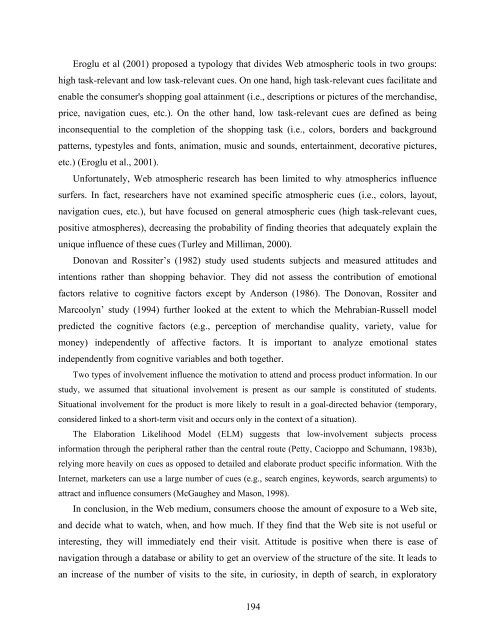Quality, value, satisfaction, trust, a
Quality, value, satisfaction, trust, a
Quality, value, satisfaction, trust, a
You also want an ePaper? Increase the reach of your titles
YUMPU automatically turns print PDFs into web optimized ePapers that Google loves.
Eroglu et al (2001) proposed a typology that divides Web atmospheric tools in two groups:<br />
high task-relevant and low task-relevant cues. On one hand, high task-relevant cues facilitate and<br />
enable the consumer's shopping goal attainment (i.e., descriptions or pictures of the merchandise,<br />
price, navigation cues, etc.). On the other hand, low task-relevant cues are defined as being<br />
inconsequential to the completion of the shopping task (i.e., colors, borders and background<br />
patterns, typestyles and fonts, animation, music and sounds, entertainment, decorative pictures,<br />
etc.) (Eroglu et al., 2001).<br />
Unfortunately, Web atmospheric research has been limited to why atmospherics influence<br />
surfers. In fact, researchers have not examined specific atmospheric cues (i.e., colors, layout,<br />
navigation cues, etc.), but have focused on general atmospheric cues (high task-relevant cues,<br />
positive atmospheres), decreasing the probability of finding theories that adequately explain the<br />
unique influence of these cues (Turley and Milliman, 2000).<br />
Donovan and Rossiter’s (1982) study used students subjects and measured attitudes and<br />
intentions rather than shopping behavior. They did not assess the contribution of emotional<br />
factors relative to cognitive factors except by Anderson (1986). The Donovan, Rossiter and<br />
Marcoolyn’ study (1994) further looked at the extent to which the Mehrabian-Russell model<br />
predicted the cognitive factors (e.g., perception of merchandise quality, variety, <strong>value</strong> for<br />
money) independently of affective factors. It is important to analyze emotional states<br />
independently from cognitive variables and both together.<br />
Two types of involvement influence the motivation to attend and process product information. In our<br />
study, we assumed that situational involvement is present as our sample is constituted of students.<br />
Situational involvement for the product is more likely to result in a goal-directed behavior (temporary,<br />
considered linked to a short-term visit and occurs only in the context of a situation).<br />
The Elaboration Likelihood Model (ELM) suggests that low-involvement subjects process<br />
information through the peripheral rather than the central route (Petty, Cacioppo and Schumann, 1983b),<br />
relying more heavily on cues as opposed to detailed and elaborate product specific information. With the<br />
Internet, marketers can use a large number of cues (e.g., search engines, keywords, search arguments) to<br />
attract and influence consumers (McGaughey and Mason, 1998).<br />
In conclusion, in the Web medium, consumers choose the amount of exposure to a Web site,<br />
and decide what to watch, when, and how much. If they find that the Web site is not useful or<br />
interesting, they will immediately end their visit. Attitude is positive when there is ease of<br />
navigation through a database or ability to get an overview of the structure of the site. It leads to<br />
an increase of the number of visits to the site, in curiosity, in depth of search, in exploratory<br />
194














